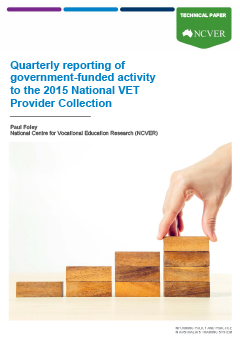Description
The topic of more frequent and timely vocational education and training (VET) data has been an issue of interest for a number of years. Since 2015, NCVER has collected and reported data on government-funded students and courses on a quarterly basis. These quarterly data submissions are cumulative and allow additional data to be reported and corrections made to previously submitted data.
The first year of quarterly reporting has provided a useful insight into how training activity is reported by the different jurisdictions over a calendar year. This paper presents the results of some initial analysis of that data using the reporting scope that was in place for 2015 reporting, broadly defined as all activity delivered by government providers and government-funded activity delivered by community education and other registered providers.
Summary
Executive summary
Since 2015, the National Centre for Vocational Education Research (NCVER) has collected and reported data on government-funded students and courses on a quarterly basis. The quarterly data submissions from state government departments responsible for training are cumulative, which allows additional data to be reported and corrections made to previously submitted data. The four reporting and submission periods are:
- January to March, submitted in May
- January to June, submitted in August
- January to September, submitted in November
- January to December, submitted in March.
The first year of quarterly reporting has provided a useful insight into how training activity is reported by the different jurisdictions over a calendar year. This paper presents the results of some initial analysis of that data using the reporting scope that was in place for 2015 reporting, broadly defined as all activity delivered by government providers and government-funded activity delivered by community education and other registered providers.
Students
Analysis shows that nationally, 49.3% of the annual student numbers were reported to NCVER in the first quarterly submission (January to March 2015). There was, however, considerable variation among the states and territories in the proportion of students reported in the first quarter — ranging from 25.9% in South Australia to 56.3% in Tasmania. The low proportion of students (25.9%) in South Australia appears to be an anomaly associated with the first year, as numbers have increased by 63.1% in the January to March 2016 data submission. Therefore, it is expected that — nationally — the proportion reported in the first quarterly submission will increase in 2016.
Programs
Program enrolments follow an expected pattern, with a higher proportion of diploma and higher qualifications reported in the January to March submission, compared with other qualifications. Generally, the lower the qualification level, the lower the proportion of program enrolments reported in the January to March submission and the more evenly they are distributed throughout the year.
Subjects
In 2015, there were almost 14.4 million subject enrolments reported in Australia. Of these, 5.5 million (38.6%) were reported in the January to March submission, of which only 1.5 million subjects had been reported with a final result. The remaining 4 million enrolments were either continuing studies or not yet available outcomes. As a greater number of subject enrolments are reported in each quarterly submission, the proportion with a finalised outcome increases and the proportion with ‘continuing’ or ‘not yet available’ outcomes decreases.
Qualifications completed
One of the proposed benefits of quarterly reporting is that data on qualifications completed could be reported sooner. The reporting of qualifications completed for government-funded activity currently has a lag of one year, as NCVER waits for additional data to be reported subsequent to the year the qualification was completed.
This analysis shows that the majority of qualifications completed within a calendar year are reported in the January to December submission, providing sufficient information to allow preliminary qualifications completed data to be reported in the year the qualification was completed. For example, 86.7% of 2014 qualifications completed were reported in the January to December 2014 submission, with 97.2% of all 2014 qualifications completed reported by the middle of the following year.
Summary
A number of revisions to previously submitted data are evident in the quarterly data. Some of these revisions were due to the changes in reporting practices, while others addressed data quality issues in previously submitted data. It will most likely take a few years of quarterly reporting before data submissions stabilise sufficiently enough to be used as reliable trend indicators of annual training activity.
